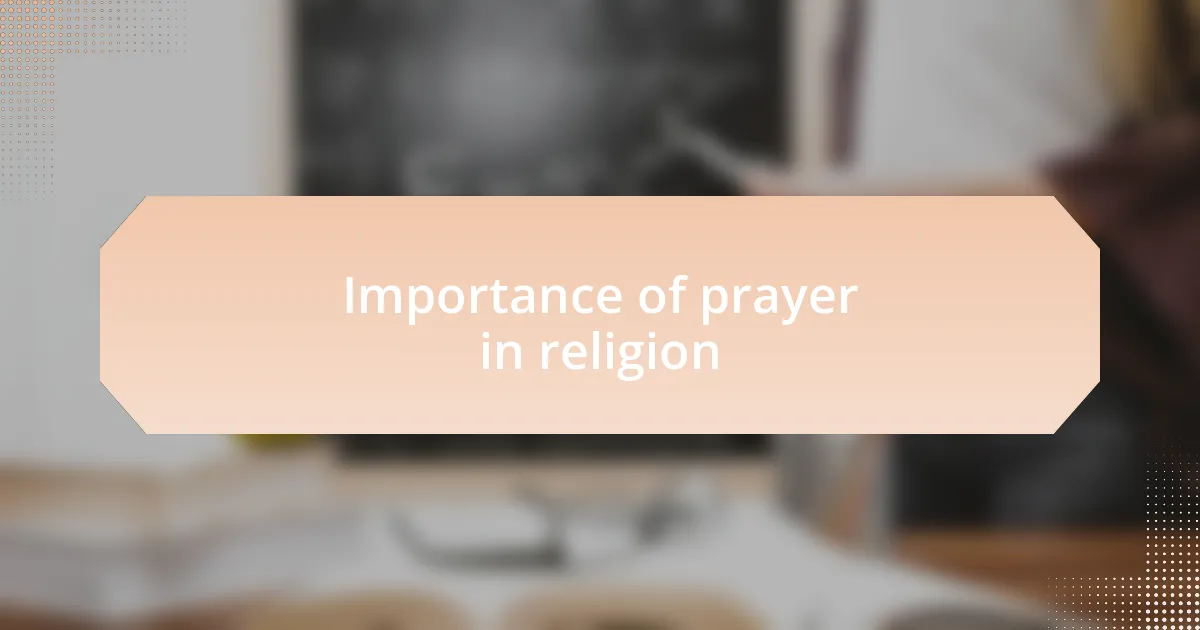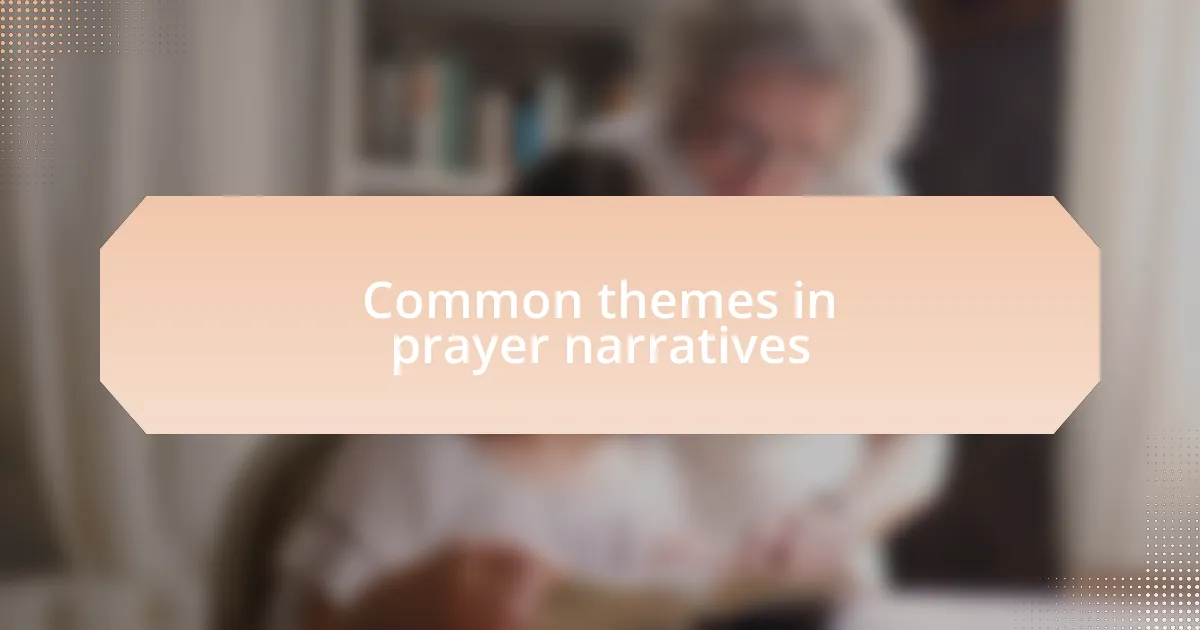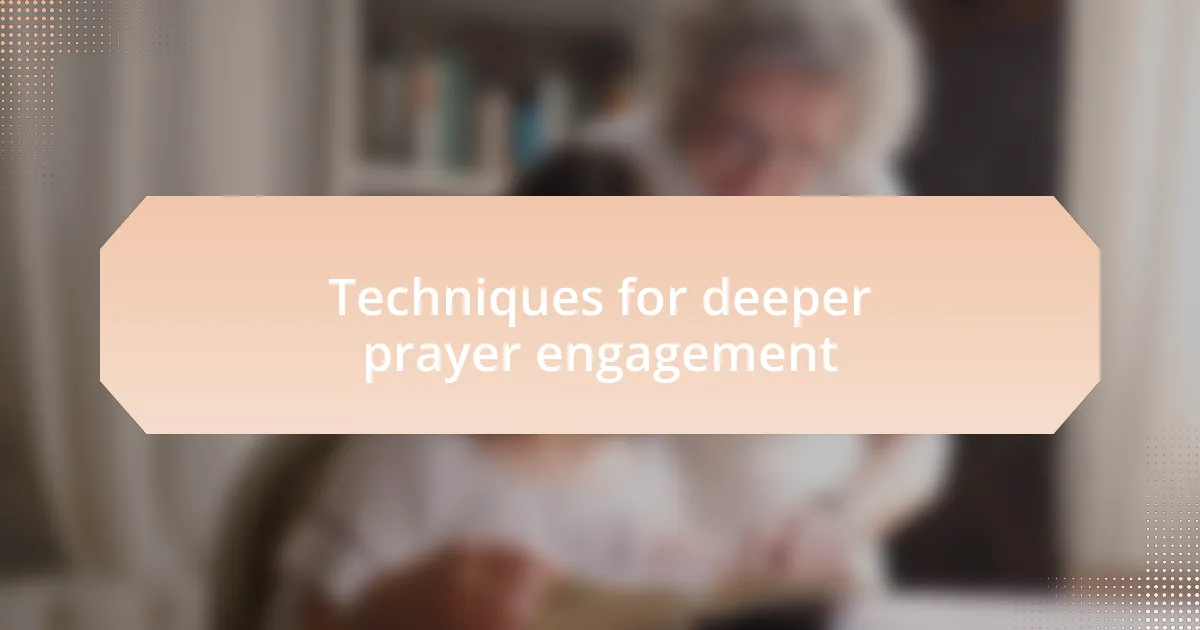Key takeaways:
- Prayer narratives reflect personal struggles, emotions, and foster a connection with the divine through vulnerability and authenticity.
- Prayer serves as a vital practice in religion, providing guidance, gratitude, and community, reinforcing personal relationships with spirituality.
- Themed experiences in prayer often involve transformation, connection, and understanding, leading to significant shifts in mindset and perspective.
- Engaging with prayer can be enhanced by creating a dedicated environment, utilizing scriptures, and incorporating sensory elements for a deeper spiritual experience.

Understanding prayer narratives
Prayer narratives are deeply personal stories that often reflect our innermost thoughts and feelings. I remember a time when I faced a significant challenge in life, and in my prayers, I poured out my fears and hopes, creating a narrative that helped me process what I was going through. Have you ever experienced that sense of clarity that follows a heartfelt prayer? It’s as though the act of articulating our struggles in prayer shapes the very way we confront them.
As I’ve explored various prayer narratives, I’ve noticed they often weave together elements of vulnerability and strength. For instance, when I share my prayer experiences with friends, I see how they resonate with similar moments in their lives, revealing a universal thread that connects us all. Isn’t it fascinating how our unique stories can unlock collective wisdom in prayer, guiding us toward healing?
Moreover, embracing a prayer narrative doesn’t mean it’s perfect or scripted. I’ve found that some of my most profound moments in prayer come when I abandon formal structure and simply speak from the heart, allowing my narrative to flow freely. This spontaneity not only invites authenticity but also cultivates a deeper relationship with the divine. How do you feel when you let go of formality in your prayers? I believe it often leads to richer, more genuine connections.

Importance of prayer in religion
Prayer serves as a lifeline in religious practice, offering individuals a space for reflection and connection with the divine. I recall a moment when I felt utterly lost, and in prayer, I found solace and guidance, realizing that this act was more than just speaking— it became a dialogue that deepened my faith. Have you ever felt that sense of peace wash over you after sharing your thoughts with God? It’s profoundly comforting, reminding us of prayer’s crucial role in cultivating a personal relationship with spirituality.
In many religious traditions, prayer is not only about asking for help but also about expressing gratitude and seeking understanding. I remember a time when I focused on gratitude in my prayers, and I was surprised by how shifting my perspective lifted my spirits. By recognizing the blessings in our lives, we strengthen our bond with the divine and foster a sense of community within our beliefs. Isn’t it interesting how words of thanks can transform our outlook on life?
Moreover, prayer acts as a powerful means of communal support, bringing people together to share their burdens and joys. When I join others in prayer, there’s an unmistakable sense of unity and purpose. Have you ever participated in a group prayer? The shared energy can be incredibly uplifting, reinforcing that we are never alone in our struggles. In this way, the importance of prayer transcends personal need—it builds bridges and nurtures collective strength within a congregation.

Common themes in prayer narratives
Prayer narratives often reveal a theme of vulnerability, showcasing the raw, human experience of seeking divine intervention. I recall a moment when I poured out my fears in a prayer, feeling utterly exposed yet comforted by the knowledge that it was safe to lay bare my soul. Does this openness resonate with you? There’s something incredibly powerful about admitting our weaknesses, as it allows us to connect with a deeper part of ourselves and the divine.
Another common theme revolves around transformation. I have often experienced how prayer can lead to significant shifts in my mindset or circumstances. For instance, after dedicating time to prayer, I found that my attitude toward a challenging situation brightened, empowering me to face it with renewed strength. Have you ever noticed how a simple conversation with God can alter your perspective? These moments of awakening remind us that prayer isn’t just a routine; it’s a catalyst for personal change.
Lastly, a prevalent theme in prayer narratives is the quest for connection and understanding. At times, I’ve walked into prayer feeling confused or alone, only to emerge with clarity and a sense of belonging. Isn’t it fascinating how the act of praying can bridge that gap between isolation and community, offering insights that enhance both our faith and our relationships? Through communal prayers and personal reflections, we often find that our search for understanding leads us to a deeper appreciation of our spiritual journeys.

Personal reflections on prayer experiences
During my own prayer experiences, I’ve often recognized a profound sense of peace wash over me, especially in moments of turmoil. I vividly remember a night when the weight of the world felt unbearable; sitting quietly, I sought solace in prayer. As I spoke quietly to God, the tension eased, almost as if my burdens were being gently lifted. Have you ever felt that serene release during prayer?
There’s a unique intimacy that develops through consistent prayer. I find that, over time, my conversations with God evolve into a dialogue rather than a monologue. I recall a period in my life when I questioned my path; it was through persistent prayer that I discerned my purpose more clearly. Isn’t it revealing how these conversations shape our understanding of ourselves?
In my journey, I’ve also discovered that prayer can catalyze gratitude. Reflecting on my life during prayer often prompts me to recognize blessings that I might otherwise overlook. For instance, after a particularly challenging week, I took a moment to express thanks for the small but significant ways love manifested around me. Can you relate to the shift that gratitude brings to your perspective? It’s truly transformative, turning even the simplest moments into a tapestry of appreciation.

Techniques for deeper prayer engagement
Finding techniques to engage more deeply in prayer can truly enhance our spiritual experience. One method I’ve found effective is setting aside a specific time and place for prayer. I remember designating a quiet nook in my home, surrounded by soft lighting and meaningful mementos. This intentional space became a sanctuary for my thoughts and prayers. Have you ever found that creating a dedicated environment changes your mindset? It brings a certain reverence to the practice that I deeply cherish.
Another technique involves using scriptures or inspirational texts as a springboard for my prayers. I often choose a scripture verse and meditate on its meaning before I begin praying. This practice allows me to connect my feelings and thoughts with the wisdom of those ancient words. I’ve had moments when a particular verse seemed to resonate with the struggles I faced that day. Isn’t it remarkable how words can sometimes feel like they were written just for us?
Incorporating sensory elements can also deepen my engagement. Sometimes, I light a candle or use essential oils while I pray, which creates a calming atmosphere that heightens my focus. On a particularly exhausting day, I remember lighting a soothing lavender candle; the aroma enveloped me, grounding my thoughts. Have you ever noticed how engaging multiple senses can enhance your spiritual practices? It’s in these moments that I truly feel connected and present in my prayers.